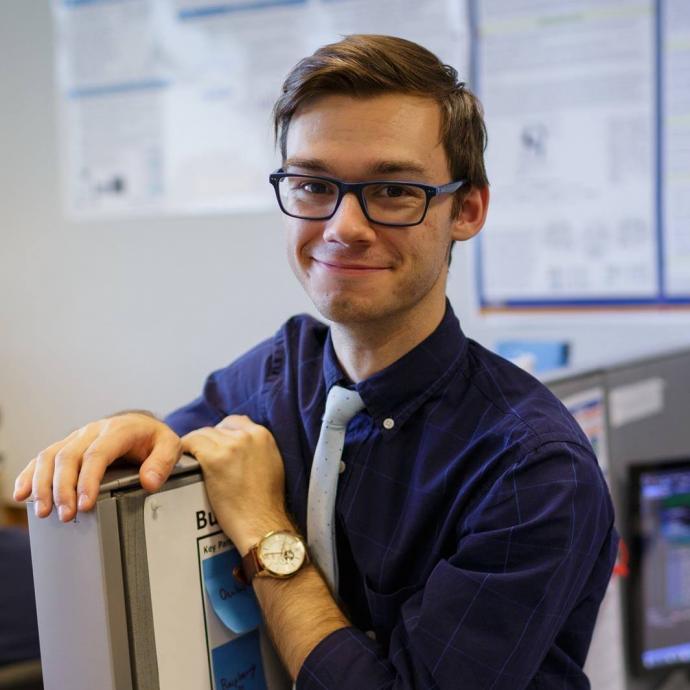Virtual Reality to Help with Binocular Vision Disorders

John Vito, NSF I-Corp participate and graduate of NJIT, with a B.S. in Biomedical Engineering, and an M.S. in Biomedical Engineering developed a novel integration of consumer-ready virtual reality headsets and custom-made eye tracking hardware and software to aid patients in vision therapy.
Tell us about your product.
Virtual Reality Vision Therapy (VRVT) is a novel combination of consumer-available electronics and traditional vision therapy principles. Over 15% of the general population suffers from a binocular vision disorder; specifically, 5% of the population (both adults and children) suffers from convergence insufficiency (CI). Nearly 75% of patients who complete office-based therapy for CI experience a clinically significant reduction in visual symptoms; however, less than 3% of the CI population seek treatment annually. Moreover, patients in the 8-18 age range show decreased therapy compliance due to the repetitive nature of the therapy procedure. Using a head mounted display with integrated eye tracking, VRVT promotes patient compliance through a suite of engaging video game experiences. These experiences mimic established vision therapy principles that have documented effectiveness, but do so in new and appealing ways, especially within the pediatric population. This approach allows for objective assessments of patient progress throughout the course of vision therapy, while encouraging patient adherence in both office-based and home therapy environments. This technology encompasses not only a therapy game, but also unparalleled levels of clinician control, eye tracking data storage and analysis, a VR-based diagnostic software, and a series of accompanying multimedia to increase patient engagement outside the therapy environment.
What inspired this project?
Dr. Tara Alvarez recruited me to work in her Vision and Neural Engineering Laboratory at the beginning of my junior year. Dr. Alvarez specializes in determining the neural underpinnings that control a variety of eye movements, and discovering neural changes before and after common vision therapy paradigms. Other members of the lab were beginning to experiment with an early development kit of the Oculus Rift, but no one was working with it full time. After spending a semester learning about Dr. Alvarez’s lab, and speaking to her primary clinical collaborator, Dr. Mitchell Scheiman, as well as members of NJIT’s IT department, we established a plan for my first summer in the lab - I was tasked with integrating eye tracking into an Oculus Rift. We hoped that we could eventually design a game that used eye movements as a game input, rather than a traditional keyboard or game controller. We hoped that we could take the mechanisms of vision therapy that have proven effectiveness and apply basic game mechanic principles to create a vision therapy experience more enjoyable for children who suffer from vision disorders.
How did you get involved with the NSF I-Corp Program?
NJIT’s recently retired manager of Patents and Licensing Administration, Carl Georgeson, introduced our team to Judith Sheft and Michael Erlich, who lead the i-Corps site at NJIT. No one on our team had any prior business experience, so we sought not only the funds from the grant, but also the entrepreneurial training and customer research.
How important was it to receive the NSF I-Corp grant? And how has it helped you achieve your goals and push your product along?
The i-Corps min-grant provided more than just the funds to purchase some equipment for the project. Importantly, it gave us the outside-the-lab experience to narrow our focus in product development. By speaking to potential customers, we solidified our vision as a team, became motivated to complete our work in a timely manner. Lastly, the grant served as a foot in the door for the national i-Corps program, which we are currently applying for.
What’s next for your project, what does success look like for you?
Success looks like waking up every morning, heading over to the lab with a smile on my face, enjoying the company of my team members, and working on something truly groundbreaking. Our team is currently forming a startup company, working toward a half a million dollar investment, and hopefully participating in an upcoming national i-Corps cohort. We’re still trying to decide on a company name, though.
To what do you attribute your success?
A common philosophy among rock climbers is that the best way up a wall is the route that requires the least expenditure of energy. As an avid climber myself, and one who subscribes to that idea, I think that our success can be attributed to the same philosophy. This project started with a very small goal, one that could be accomplished by a single undergraduate student. As the project grew, and our team grew, our concept of the quickest way up the wall, or our minimum viable product, has also grown; however, we have always progressed in very small steps, with the least resources possible. By not overextending or overselling ourselves, we have maintained a steady stream of innovation while remaining comfortable within our limited resources.
